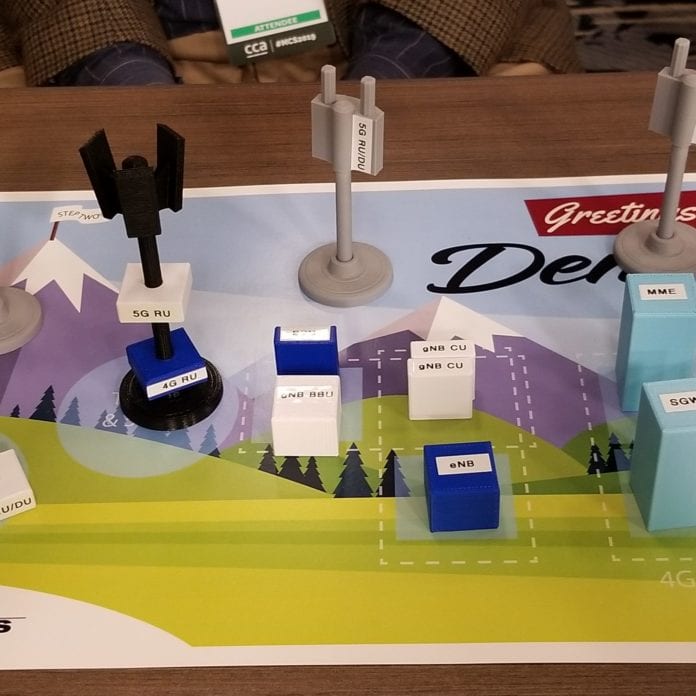AURORA, COLORADO — The black monopole macro sites and gray small cells went up easily, the architecture shifting seamlessly from LTE to non-standalone 5G New Radio and then to standalone 5G. It’s just that easy –when all the network elements are miniature, plastic versions of the real thing, neatly labeled and board-game-sized.
During a session at the Competitive Carriers Association’s Mobile Carriers Show this week, attendees had a chance to get their hands on small-scale network models to take a “hands-on” approach to the real-life implications that the transition to 5G will have on cellular network architecture.
Mark Harms, senior consultant – technology for business at Award Solutions, paced the room, explaining the changes that cellular operators will have to navigate over the coming years.
“I’m not suggesting deploy now,” Harms told the audience. “I’m suggesting — learn.”
Each carriers’ specific situation depends on several factors, he said, including their spectrum holdings, when they purchased their LTE radios (some recently introduced models can support both 4G and 5G) and which vendors they use. The intermediate step to Nonstandalone 5G — which is the first 5G implementation that most large carriers are planning and starting deployment on — probably won’t get carriers all the way to the ultra-low latencies and ultra-high connection densities that Standalone will, Harms noted, although he added that “there are use cases that I think this is still useful for.” If smaller network operators have millimeter wave spectrum, they are more likely to be able to gain some of the latency and high throughput benefits, he added.
Much like the broader industry conversation around 5G has focused on potential use cases, Harms urged CCA member companies to figure out what use cases they want to support, and use that as a basis for their network plans.
“There are lots of radio network architecture decisions that have to be made depending on use case,” he said. First, network operators should figure out what problems they are trying to solve for, then move on to what the right applications are, who needs it and where they can start with small deployments to learn the lessons that they need to. But he warned against buying equipment now that is not upgradeable to 5G — and he also said that if smaller carriers have not yet started their transition to virtualized networks, they need to get there in order to have the foundation for 5G.
“Don’t put it off — start thinking, planning and preparing,” Harms said.
A more aggressive take came from a later panel on spectrum strategies, where the discussion shifted more in the direction of 5G offersing a chance for rural operators to be in near-lock-step with launches of the larger carriers. Smaller, rural operators should also be tracking which national carrier has holdings in the same bands that they do and their 5G device development, which will drive the overall equipment and device ecosystem that they have access to, said Nokia’s David Fritz, senior consulting engineer.
“I don’t think the rural guys should wait for 5G, especially with some of the functionality that we’re bringing in, like dynamic spectrum sharing which basically enables you to simultaneously operate 4G and 5G on the existing equipment,” said Ericsson North America’s GS Sickand, CTO for regional carriers. “You need to make the decision, when do you want to be competitive with some of the Tier Ones who are going to over-build and provide services?”

